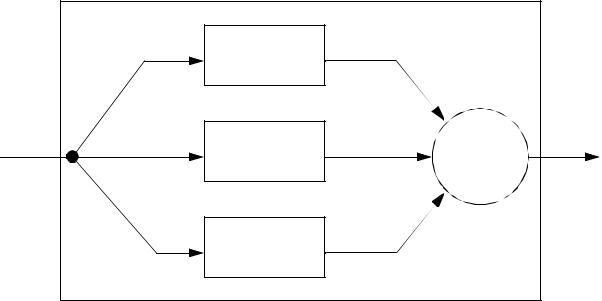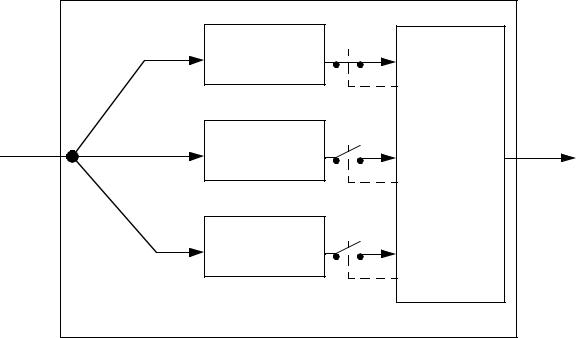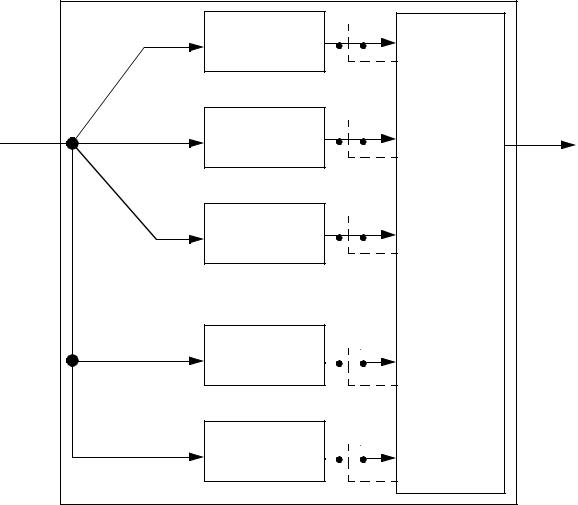
- •1. TABLE OF CONTENTS
- •2. ENGINEERING EDUCATION
- •2.1 PROBLEM SOLVING PHILOSOPHY
- •2.1.1 Tips When Solving Problems
- •2.2 STUDYING ENGINEERING COURSES
- •2.3 THE TOPICS OF MECHANICAL ENGINEERING
- •2.4 CALCULATIONS IN ENGINEERING
- •2.4.1 Units
- •2.4.2 Significant Figures
- •2.5 FUNDAMENTAL THEORIES
- •2.5.1 Newton’s Laws
- •3. THE PROFESSIONAL PRACTICE OF ENGINEERING
- •3.1 ADMINISTRIVIA
- •3.1.1 OBJECTIVES
- •3.1.2 COURSE INFORMATION
- •3.2 THE PROFESSION OF ENGINEERING
- •3.2.1 DEFINITION OF ENGINEERING
- •3.2.2 THE BASIC ELEMENTS OF PROFESSIONAL ENGINEERING
- •3.2.2.1 - Associations and Titles
- •3.2.2.2 - Technical
- •3.2.2.3 - The Professional Practice Examination (PPE)
- •3.2.2.4 - The License
- •3.2.2.5 - Discipline and Enforcement
- •3.2.2.6 - Experience and Character
- •3.2.3 IN GENERAL
- •3.2.3.1 - The Professional Image
- •3.2.3.2 - The Overlap of Engineers and Architects
- •3.2.4 HISTORY OF PROFESSIONAL ENGINEERING IN ONTARIO
- •3.2.4.1 - The Role of The PEO
- •3.3 REFERENCE
- •3.3.1 ENGINEERING ASSOCIATIONS
- •3.4 ETHICS
- •3.4.1 Typical Misconduct Guidelines
- •3.4.2 Typical Ethics Guidelines,
- •3.4.3 Whistle Blowing (aka A Professional Engineers Duty to Report)
- •3.4.4 OLD PPE QUESTIONS FOR PEO
- •3.4.4.1 - Ethics Questions
- •3.4.5 HOW TO APPROACH LAW/ETHICS PROBLEMS
- •3.5 LAW IN GENERAL
- •3.6 BUSINESS LAW
- •3.7 CIVIL LAW
- •3.7.1 CONTRACTS
- •3.7.1.1 - Engineering Contracts
- •3.7.1.2 - Tort Liability and Contract Liability - Concurrently
- •3.7.1.3 - Construction Contracts
- •3.7.1.4 - Liens
- •3.7.2 EMPLOYMENT
- •3.8 CRIMINAL LAW
- •3.8.1 A Duty of Honesty
- •3.8.2 The Combines Investigations Act
- •3.9 REFERENCE
- •3.9.1 ENGINEERING ASSOCIATIONS
- •4. INTELLECTUAL PROPERTY
- •4.1 PATENTS
- •4.2 TRADEMARKS
- •4.3 COPYRIGHT
- •4.4 INDUSTRIAL DESIGN
- •4.5 TRADE SECRETS
- •4.6 REFERENCES
- •5. NEGLIGENCE & LIABILITY
- •5.1 REFERENCES
- •5.2 LAW IN GENERAL
- •5.3 BUSINESS LAW
- •5.4 CIVIL LAW
- •5.4.1 CONTRACTS
- •5.4.1.1 - Engineering Contracts
- •5.4.1.2 - Tort Liability and Contract Liability - Concurrently
- •5.4.1.3 - Construction Contracts
- •5.4.1.4 - Liens
- •5.4.2 EMPLOYMENT
- •5.5 CRIMINAL LAW
- •5.5.1 A Duty of Honesty
- •5.5.2 The Combines Investigations Act
- •5.6 REFERENCE
- •5.6.1 ENGINEERING ASSOCIATIONS
- •5.6.2 Intellectual Property
- •5.6.2.1 - Patents
- •5.6.2.2 - Trademarks
- •5.6.2.3 - Copyright
- •5.6.2.4 - Industrial Designs
- •5.6.2.5 - Trade Secrets
- •5.6.3 TORT/NEGLIGENCE
- •5.7 CANADIAN CASES
- •5.7.1 Alkok v. Grymek
- •5.7.2 Amber Size & Chemical Co. Ltd. v. Menzel
- •5.7.3 Application of Erickson/Massey
- •5.7.4 Armbro Materials and Construction Ltd. v. 230056 Investments Limited et. al.
- •5.7.5 Attorney-General of Canada v. Libling et. al.
- •5.7.6 Bahamaconsult Ltd. v. Kellogg Salada Canada Ltd.
- •5.7.8 Belle River Community Arena Inc. v. W.J.C. Kaufmann Co. et. al.
- •5.7.9 Bethlehem Steel Corporation v. St. Lawrence Seaway Authority
- •5.7.10 Brennan Paving Co. Ltd. v. Oshawa
- •5.7.11 British Reinforced Concrete Engineering Co. Limited v. Lind
- •5.7.13 Calax Construction Inc. v. Lepofsky
- •5.7.15 City of Kamloops v. Nielsen et. al.
- •5.7.16 Conwest Exploration Co. Ltd. et. al. v. Letain
- •5.7.17 Corporation of District of Surrey v. Carrol-Hatch et. al.
- •5.7.18 Croft Construction Co. v. Terminal Construction Company
- •5.7.19 Dabous v. Zuliani et. al.
- •5.7.20 Davis Contractors Ltd. v. Fareham Urban District Council
- •5.7.21 Demers et. al. v. Dufresne Engineering et. al.
- •5.7.22 Derry & Peek
- •5.7.23 Dominion Chain Co. Ltd. v. Eastern Construction Co. Ltd. et. al.
- •5.7.24 Donoghue v. Stevenson
- •5.7.25 Dutton v. Bognor United Building Co. Ltd.
- •5.7.26 Englewood Plumbing & Gas Fitting Ltd. v. Northgate Development Ltd. et. al.
- •5.7.27 Fairbanks Soap Co. Ltd. Sheppard
- •5.7.28 Fern Brand Waxes Ltd. v. Pearl
- •5.7.29 Ford Homes Ltd. v. Draft Masonry (York) Co. Ltd.
- •5.7.30 General Electric Company, Limited v. Fada Radio, Limited
- •5.7.31 GeorgeHo Lem v. Barotto Sports Ltd. and Ponsness-Warren Inc.
- •5.7.32 Grant Smith & Co. v. The King
- •5.7.33 Hadley v. Baxendale
- •5.7.34 Halverson Inc. v. Robert McLellan & Co. et. al.
- •5.7.35 Harbutt’s Plasticine Ltd. v. Wayne Tank and Pump Co. Ltd.
- •5.7.36 Hedley Byrne & Co. Ltd. v. Heller & Partners Ltd.
- •5.7.37 Imperial Glass Ltd. vs. Consolidated Supplies Ltd.
- •5.7.38 Jackson et. al. v. Drury Construction Co. Ltd.
- •5.7.39 John Burrows Ltd. v. Subsurface Surveys Ltd. et. al.
- •5.7.40 Junior Books Ltd. v. Veitchi Co. Ltd.
- •5.7.41 Kamlee Construction Ltd. v. Town of Oakville
- •5.7.42 Kidd v. Mississauga Hydro-Electric Commission et. al.
- •5.7.43 Kocotis v. D’Angelo
- •5.7.44 Lambert v. Lastoplex Chemicals Co. Limited et. al.
- •5.7.45 MacMillan Bloedel Ltd. v. Foundation Co.
- •5.7.46 Markland Associates Ltd. v. Lohnes
- •5.7.47 Metropolitan Water Board v. Dick, Kerr and Company, Limited
- •5.7.48 Monticchio v. Torcema Construction Ltd. et. al.
- •5.7.49 The Moorcock
- •5.7.50 Murray v. Sperry Rand Corporation et. al.
- •5.7.51 Mutual Finance Co. Ltd. v. John Wetton & Sons Ltd.
- •5.7.52 Nedco Ltd. v. Clark et. al.
- •5.7.53 Newman et. al. v. Conair Aviation Ltd. et. al.
- •5.7.54 Northwestern Mutual Insurance Co. v. J.T.O’Bryan & Co.
- •5.7.55 J. Nunes Diamonds Ltd. v. Dominion Electric Protection Co.
- •5.7.56 Owen Sound Public Library Board v. Mial Developments Ltd. et. al.
- •5.7.57 Permutit Co. v. Borrowman
- •5.7.58 Photo Production Ltd. v. Securicor Transport Ltd.
- •5.7.59 Pigott Construction Co. Ltd. v. W.J. Crowe Ltd.
- •5.7.60 Pirelli General Cable Works Ltd. v. Oscar Faber and Partners
- •5.7.61 Pym v. Campbell
- •5.7.62 The Queen et. al. v. Commercial Credit Corp. Ltd.
- •5.7.63 Ramsay and Penno v. The King
- •5.7.64 Regina v. Margison and Associates, Limited
- •5.7.65 Rex v. Bentall
- •5.7.66 Rivtow Marine Ltd. v. Washington Iron Works et. al.
- •5.7.67 Robert Simpson Co. Ltd. v. Foundation Co.
- •5.7.68 Ron Engineering et. al. v. The Queen in right of Ontario et. al.
- •5.7.69 Royal British Bank v. Turquand
- •5.7.70 Salomon v. Salomon & Co. Ltd.
- •5.7.71 Schewebel v. Telekes
- •5.7.72 Sealand of the Pacific Ltd. v. R.C. McHaffie Ltd. et. al.
- •5.7.73 Sparham Souter et. al. v. Town & Country Developments (Essex) Ltd. et. al.
- •5.7.74 Sutcliffe v. Thackrah et. al.
- •5.7.76 Re Thomas Hackett
- •5.7.77 Township ofMcKillop v. Pidgeon and Foley
- •5.7.78 Trident Construction Ltd. v. W.L. Wardrop and Assoc. et. al.
- •5.7.80 Viscount Machine and Tool Ltd. v. Clarke
- •5.7.81 Willard’s Chocolates Ltd. v. Bardsley
- •5.7.82 GLOSSARY
- •5.7.83 OLD PPE QUESTIONS FOR PEO
- •5.7.83.1 - Law Questions
- •5.7.84 HOW SOLVE TO LAW/ETHICS PROBLEMS
- •5.7.85 A NOTE TO YOU
- •6. LEARNING AND TEACHING
- •6.1 LEARNING IN GENERAL
- •6.1.1 Learning Theories
- •6.1.2 References/Bibliography
- •6.2 ON-LINE LEARNING
- •6.2.1 Relevant WWW Sites
- •6.2.2 References/Bibliography
- •7. THE ENVIRONMENT
- •7.1 ENVIRONMENTAL PROTECTION AGENCY (EPA)
- •7.2 LEGISLATION
- •7.2.1 Clean Air Act (CAA) 1970
- •7.3 OCCUPATION SAFETY AND HEALTH ADMINISTRATION (OSHA)
- •7.4 PRACTICE PROBLEMS
- •8. SYSTEM DESIGN
- •8.1 SYSTEM FAILURE
- •8.1.1 Introduction
- •8.1.2 The Theory of Module Reliability and Dependability
- •8.1.3 The Theory of System Reliability
- •8.1.4 Design For Reliability (DFR)
- •8.1.4.1 - Passive Redundant
- •8.1.4.2 - Active Redundant
- •8.1.4.3 - Hybrid Active
- •8.1.4.4 - Other Design Points
- •8.1.5 Formal Methods For Failure Modelling
- •8.1.5.1 - Event Trees
- •8.1.5.2 - Fault Trees
- •8.1.5.3 - Causes Trees
- •8.1.6 Error Sources
- •8.1.7 Risk Control During Design
- •8.1.7.1 - Failure Modes and Effects Analysis (FMEA)
- •8.1.7.2 - Critical Items List (CIL)
- •8.1.7.3 - Failure Modes, Effects, and Criticality Analysis (FMECA)
- •8.1.7.4 - Hazard Causal Analysis (HCA)
- •8.1.7.5 - Interface Analysis
- •8.1.8 Management of Reliability
- •8.1.8.1 - Preliminary Hazard Analysis (PHA)
- •8.1.9 Implemented Risk Management Programs
- •8.1.9.1 - NASA Safety Methods
- •8.1.10 References and Bibliography
- •8.2 PRACTICE PROBLEMS
- •8.2.1 Design Applications of Risk Management
- •8.2.1.1 - The Space Shuttle Orbiter Control Computers
- •8.2.1.2 - A Mobile Service Robot for the Space Station
- •8.2.2 Case Studies In Failure
- •8.2.2.1 - Apollo 204
- •8.2.2.2 - Apollo 13
- •8.2.2.3 - The Challenger
- •8.2.3 Assignment Problems
- •8.2.4 Glossary
- •8.2.5 References and Bibliography
- •9. FORMULAS
- •9.1 ELECTRICAL RELATIONSHIPS
- •9.2 MECHANICAL FORMULAS
page 178
n – m |
|
|
|
|
|
|
Rm;n( t) = ∑ |
|
n |
( R( t) ) |
( n – i) |
( 1 – R( t) ) |
i |
|
|
|
|
|||
|
|
i |
|
|
|
|
i = 0 |
|
|
|
|
|
|
where, |
|
|
|
|
|
|
Rm;n( t) |
= |
reliability of a system that contains m of n parallel modules |
||||
|
R( t) |
|
n |
= |
|
i |
||
|
= the reliability of the modules at time t
n!
--------------------
( n – i) !i!
•keep in mind that many systems are a combination of series and parallel units, to find the total reliability, calculate the reliability of the parallel units first, and then calculate the series reliability, replacing the parallel units with their grouped reliability.
•availability is the chance that at any time a system will be operational. This can be determined experimentally, or estimated. For a system that is into it’s useful lifetime, this can be a good measure. Note that at the beginning, and end of its life, this value will be changing, and will not be reliable.
A( t) |
|
to |
|
MTTF |
|
MTTF |
|
1 |
|
= |
------------- |
= |
-------------------------------------- |
= |
---------------- |
= |
------------ |
||
to + tr |
MTTF + MTTR |
MTBF |
|
λ |
|||||
|
|
|
|
|
|
|
|
1 + |
µ-- |
where,
A( t) = probability that a system will be available at any time
to = hours miotpedniarvtr
tr = hoursmpiotidaervpairn
8.1.4 Design For Reliability (DFR)

page 179
8.1.4.1 - Passive Redundant
• three identical, yet independent systems are used to produce three outputs. The three outputs are compared and a voting procedure is used to select one. This method is called Triple Modular Redundancy (TMR)
|
Module 1 |
|
|
system |
|
|
|
state |
|
|
|
and |
|
|
control |
set-points |
Module 1 |
vote for |
output |
|
|
||
|
best 2 out |
|
|
|
|
|
|
|
|
of 3 |
|
|
Module 1 |
|
|
•In this event, if there is a random failure in any of the modules, it will be outvoted by the others, and the system will continue to operate as normal.
•This type of module does not protect against design failures, where all three modules are making the same error. For example if all three had Intel Pentium chips with the same math mistake, they would all be in error, and the wrong control output would result.
•This module design is best used when it is expected that one of the modules will fail randomly with an unrecoverable state.
•This type of system can be used easily with computer algorithms and digital electronics.
8.1.4.2 - Active Redundant
• A separate monitoring system tracks the progress of separate modules. In the event one of the modules is believed to have failed, it is taken off line, and replaced with a new module.

page 180
Prime |
MONITOR |
|
|
|
|
||
system |
|
|
|
state |
examine |
|
|
and |
|
||
prime module, |
control |
||
set-points |
|||
if error is |
|||
Backup 1 |
output |
||
detected, swap |
|||
|
|
||
|
the prime for |
|
|
|
a backup |
|
|
|
module |
|
|
Backup 2 |
|
|
•This method depends upon a good design of the monitor module.
•As with the passive redundant module, this module is also best used to compensate for complete module failure.
•This type of system can be used easily with analog electronics and mechanics, as well as with switched modules.
8.1.4.3 - Hybrid Active
•A combination of the voting system and the reconfiguration system
•the voting modules continue to make decisions, but voting members can be replaced with backup units.

page 181
Module 1 |
MONITOR/ |
|
VOTER |
||
|
||
system |
|
|
state |
|
|
and |
control |
|
set-points |
||
Module 2 |
output |
|
Module 3 |
|
|
Backup 1 |
|
|
Backup 2 |
|
8.1.4.4 - Other Design Points
•Parity and check bits can be used to detects errors in calculations. Checksums can be used for blocks of data, and grey code can be used for detecting errors in sequential numbers.
•The amount of redundant hardware can be reduced by doing the same calculation twice, at different points in time on the same processor. If the results are compared, and found to be different. This would indicate a transient fault. This can be important in irradiated environments where bits can be flipped randomly.
•Software redundancy involves writing multiple versions of the same algorithm/program. All of the algorithm versions are executed simultaneously. If a separate acceptance algorithm estimates that the primary version is in err, it is disabled, and the secondary version is enabled.
